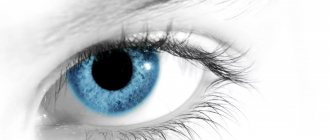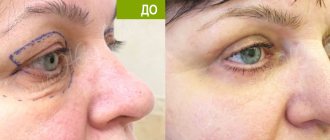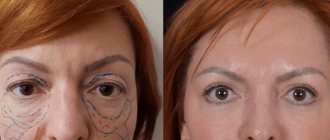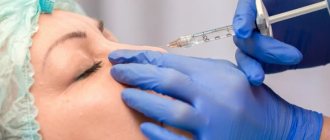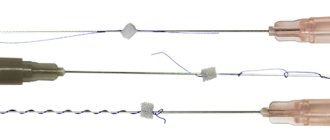Blepharoplasty - eyelid surgery
Every person has fatty tissue in the lower eyelid area. The skin itself is thin - about four times thinner than the rest of the facial skin. With a decrease in skin tone, fat appears in the form of characteristic hernias. In addition, fluid can accumulate in the fatty tissues of the eyelids. Its excess increases swelling of the eyelids.
People with bags under their eyes are often suspected by those around them of secret vices, of an immoderate passion for alcohol. Their appearance evokes thoughts, at a minimum, of physical ill health. Sometimes swollen lower eyelids actually indicate poor kidney or heart function. But the same bags under the eyes may not be related to diseases of the internal organs and are predetermined by hereditary factors.
The circumstances why fatty hernias protrude more strongly can be very different. It happens that the body reacts in this way to allergic substances, but most often the fat around the eyes becomes more noticeable because the skin of the face loses its elasticity. Internal aging processes, despite all the efforts of cosmetologists, take their toll.
You can help. Surgery to remove fatty hernias is called eyelid surgery.
or
blepharoplasty
. It takes place under light intravenous anesthesia and usually lasts 30-40 minutes. There are several options for the operation. If the skin of the eyelids is clearly stretched and there is excess of it (usually in older people), the surgeon removes or moves the fatty tissue through a mini-incision directly under the ciliary edge of the eyelid. To achieve an ideal result, it is sometimes necessary to strengthen the muscle layer of the eyelid. The surgeon then slightly tightens the sagging skin of the lower eyelids and removes excess skin. The postoperative thin scar initially looks like a small reddish scratch, then quickly fades and becomes completely invisible.
If the skin of the eyelids and the orbicularis oculi muscle have not undergone noticeable changes (usually in young people), fatty hernias are eliminated transconjunctivally: through a mini-incision on the side of the mucous membrane of the eyelid. In this case, traces of the operation are not visible at all. Finally, if the patient has slight excess eyelid skin, the plastic surgeon may combine transconjunctival surgery with laser eyelid skin peeling. Laser pulses cause a noticeable contraction of the collagen fibers of the skin, as a result of which it tightens and becomes elastic again. In any of these options there are a lot of nuances that allow the surgeon, working with a specific patient, to achieve the best aesthetic result.
Contraindications: Pulmonary, heart failure Chronic diseases of internal organs in the stage of decompensation/exacerbation Acute diseases Diabetes mellitus in the stage of decompensation Oncological diseases Presence of blood-borne infections Pregnancy, lactation Mental illness Planning pregnancy in the next 12 months Increased intraocular pressure Dry eye syndrome
Patients do not feel pain either during or after the operation. The only cause of discomfort is swelling, the degree of which varies from person to person. They can last up to 7 days. After blepharoplasty, some patients develop small bruises under the eyes, which disappear after 10-12 days. The patient is discharged from the hospital the next day after the operation and after another 1-2 days the stitches are removed.
After removing fatty hernias under the eyes, a person looks strikingly refreshed and rejuvenated. It is impossible to guess the true reason for the change that has occurred, unless he himself considers it necessary to tell the truth to his relatives or friends. By the way, you can get rid of unsightly bags under your eyes for a long time even when they are caused by kidney or heart diseases.
Blepharoplasty often complements corrections such as endoscopic face lifting, rhinoplasty, liposuction, abdominoplasty, breast surgery: breast augmentation or breast reduction, as well as some other operations.
How to get advice?
Reception of plastic surgeons is free - on weekdays from 10 to 18 hours (on Thursdays - from 12 to 18 hours), on Saturdays - from 10 to 16 hours by appointment by phone.
If you live not in Yekaterinburg, but in another city in Russia, we conduct consultations remotely, using photographs. Please read the terms and conditions for receiving a remote consultation on the “How to get a consultation” page.
ATTENTION! Smoking negatively affects the outcome of the operation, causing serious complications such as tissue necrosis. If you smoke, you must quit smoking 2 months before surgery.
THERE ARE CONTRAINDICATIONS, SPECIALIST CONSULTATION IS REQUIRED
Non-surgical technique
Non-surgical upper eyelid blepharoplasty has many advantages:
- safety; — no complications; — lack of postoperative rehabilitation; — quick and effective elimination of deficiencies; - minimal risk of injury.
You may be interested in Emoxipin eye drops: instructions for use
The main methods of non-surgical plastic surgery include:
1. Injection lift. It involves the introduction under the skin of drugs that contain natural ingredients that have a rejuvenating effect.
2. Thermolifting (heat exposure). Accelerates the synthesis of substances that are responsible for the renewal of skin cells and allow you to get rid of facial wrinkles and swelling.
3. Thermage. Rejuvenation of the skin around the eyes occurs due to the influence of radio waves, which stimulate the coagulation of collagen fibers, which leads to the smoothing of fine wrinkles. The results of the procedure can last for five years.
4. Mesothreads. This method consists of introducing special threads that tighten sagging skin.
Operation efficiency
After upper blepharoplasty
During the operation, the patient gets rid of excess skin and fat deposits. The full result can be assessed 8-12 weeks after the intervention. Throughout this period, the skin must be carefully cared for. The care complex is aimed at moisturizing and restoring the skin around the eyes.
After the intervention, significant rejuvenation of the upper eyelids is noticeable, the result lasts 8-10 years. The choice of type of blepharoplasty directly depends on the degree of age-related changes: the fewer there are, the more gentle the effect is applied.
How is rehabilitation going?
On average, the rehabilitation period after blepharoplasty takes 2-3 weeks. Immediately after surgery, the patient may feel discomfort, increased sensitivity to light, and pain. 7-14 days after surgery, the doctor removes the stitches and applies a patch, which helps reduce swelling. You need to wear it for 7-10 days. During this period, it is recommended to sleep on your back.
For home care, the doctor prescribes antiseptic drugs to treat the wound. Swelling and hematoma may increase, but you should not be afraid of this; these symptoms will soon disappear. 4 weeks after blepharoplasty, traces of surgical intervention completely disappear. You need to follow the doctor's recommendations for another 2 months. Don't forget the following rules:
- Take prescribed medications;
- Treat eyelids;
- Avoid physical activity;
- Avoid unnecessary touching of eyes;
- On applying makeup;
- Avoid alcohol and smoking;
- Don't strain your eyes.
After blepharoplasty, it is recommended to constantly use creams with an SPF factor. This will help your skin stay healthy and youthful longer. For 4 weeks you will have to give up visiting the bathhouse, sauna, swimming pool, and intense physical activity. Protect your eyes from possible injury. After a few months, the body will fully recover, the scars will heal - and it will be possible to evaluate the final result of the operation.
Rehabilitation after eyelid lift
There are clear rules that must be followed during the recovery period. The following recommendations are relevant both after surgery and after anti-aging cosmetic procedures:
- Do not expose your skin to ultraviolet radiation. You should refrain from visiting the solarium. When outdoors, you must use products containing UV filters.
- After the procedure, it is advisable to limit the use of cosmetics for several days.
- You will have to take a break from playing sports for 3 weeks.
- Do not use contact lenses.
- Do not expose the body to high temperatures: sauna, spa, hot baths are temporarily prohibited.
After surgical correction, it is necessary to reduce eye strain; try to spend as little time as possible reading, watching television programs, or working on the computer. To reduce discomfort, after surgery you can put drops in your eyes, which will be prescribed by a plastic surgeon. Decorative cosmetics cannot be used after surgery for 3 weeks.
You can get comprehensive information about eye rejuvenation methods at a personal consultation with a plastic surgeon or cosmetologist at the Soho Clinic.
Contraindications to blepharoplasty
A contraindication to lower blepharoplasty is a condition in the body in which surgical intervention can cause exacerbation of chronic diseases or lead to serious postoperative complications:
- Pregnancy, lactation.
- Oncological diseases.
- Acute and exacerbation of chronic diseases.
- Uncontrolled blood pressure.
- Blood clotting disorders.
- Purulent-inflammatory processes on the skin of the face.
- Pathologies of the endocrine system: decompensated diabetes mellitus, hyperthyroidism.
- Pathology of the eyes and eyelids: conjunctivitis, blepharitis, blepharospasm, dry eye syndrome, glaucoma and others.
There are no age restrictions for lower eyelid surgery. The possibility of performing the operation is determined by the general health of the patient, the characteristics of the skin, as well as the predicted result.
What is upper eyelid ptosis?
Upper eyelid ptosis is a drooping of the skin above the eye. One of the main reasons is a decrease in the elasticity of the skin with age. The upper eyelid is very thin and delicate. The number of collagen fibers decreases, and it loses its elasticity earlier than other integuments on the face. Eyelid ptosis can add several years of age and create a feeling of facial swelling.
Other causes of drooping upper eyelid:
- congenital “closed” eyelid;
- injuries accompanied by swelling;
- consequence of the disease.
If drooping eyelid is not associated with genetic characteristics or age-related changes, then you should pay special attention to blepharoplasty, because such an intervention can be harmful. Before the operation, do not forget to tell the surgeon in detail about your situation so that he can give quality recommendations.
Postoperative period
With seamless technology, after local anesthesia, the patient can return home within a few hours. All traces usually disappear within a week after the operation, then you can return to normal life.
If standard technology was used, using sutures and general anesthesia, the patient can be discharged within a day or after the sutures are removed (5 days).
The entire rehabilitation period takes about two months. At this time, you need to visit an ophthalmologist and make sure that everything is fine with your vision. For the first week after surgery, try to limit eye strain.
If you feel discomfort for a long time, then contact the doctor who performed the operation, he will be able to give suitable recommendations.
Cost of upper blepharoplasty
The price of the intervention differs significantly from the chosen clinic, the qualifications of the surgeon, and even the city in which the operation is planned. The cost of all types of blepharoplasty is higher in Moscow than in St. Petersburg. The table shows the approximate cost of upper eyelid surgery among leading clinics.
| Moscow (RUB) | St. Petersburg (RUB) | |
| Seamless blepharoplasty | 60000-90000 | 30000-45000 |
| Non-surgical | 15000-40000 | 10000-30000 |
| Laser | 80000-110000 | 45000-60000 |
| Transconjunctival | 80000-110000 | 35000-60000 |
| Pinch blepharoplasty | 50000-60000 | 45000-50000 |
| Canthotomy | 50000-70000 | 40000-55000 |
| Canthopexy | 30000-35000 | 20000-30000 |
Conclusion
Blepharoplasty is a great way to change the shape and shape of your eyes. The result lasts for a long time and does not require additional ongoing care. It is important that the operation is performed by an experienced, qualified specialist who is familiar with your medical history.
After blepharoplasty, there is a high risk of developing adverse reactions. Follow all recommendations carefully to minimize any negative consequences, if any. The procedure is expensive, but the result will not take long to arrive.
Like any plastic surgery, blepharoplasty has a fairly long recovery period, during which the appearance may not meet all expectations.
Non-surgical cosmetic methods are the safest, but their effectiveness is not as high as that of surgical methods, and the result lasts much less (1-2 years versus 8-10 years).
Blepharoplasty is one of the simplest and most effective procedures in aesthetic surgery.
Blepharoplasty: pros and cons
In what cases is blepharoplasty advisable?
• Excess skin hangs down, covering the natural crease of the upper eyelid. • Excess skin from the upper eyelids hangs over the eyelashes. • Puffiness of the upper and lower eyelids makes the eyes look tired or aged. • Deep wrinkles appeared under the eyes.
Procedures related to eyelid surgery
Patients undergoing blepharoplasty may also be interested in a brow or face lift, Botox injections, or contouring using special soft tissue fillers.
Advantages and disadvantages of eyelid surgery
Benefits of blepharoplasty
• The procedure will correct swelling and bags under the lower eyelids, as well as sagging skin of the upper eyelid, making the eyes look younger and healthier. • Vision problems caused by sagging eyelids will disappear. • Scars from blepharoplasty will be hidden in the natural folds of the eyelids, making them completely invisible after surgery.
Disadvantages of eyelid surgery
• The results of the procedure will only be visible after some time. • After surgery, your eyes will feel itchy and dry, as well as swelling and bruising. • You may need a brow lift if your brows droop over your eyes or you have deep furrows in your forehead.
Considering these factors will help you determine whether plastic surgery is right for you or not. However, in each specific case, consultation with a doctor is necessary. It is he who will determine the positive and negative consequences of the operation, based on your individual characteristics.
Blepharoplasty: photos before and after the procedure
Are you a good candidate for eyelid surgery?
Blepharoplasty will be appropriate for you in the following cases:
• excess skin hides the natural fold of the upper eyelids; • due to sagging skin of the upper eyelid, vision deteriorates; • puffiness of the upper eyelids makes your eyes look tired and sad; • the lower eyelid has stretched and many fine wrinkles have appeared, reminiscent of the texture of corrugated paper; • bags and black circles have formed under the eyes; • The upper eyelid is too small or not smooth enough to apply makeup.
If you are in good physical shape, have a positive attitude and are realistic about the possibilities of the procedure, then you are a good candidate for blepharoplasty.
Preparation and performance of the operation
How to prepare for eyelid surgery?
Before blepharoplasty, the surgeon will provide you with detailed instructions and answer all questions. In addition, he will study your medical history and conduct a physical examination, which will allow the doctor to determine how ready you are for surgery.
• First of all, the doctor will ask you about possible eye problems and diseases, such as dry eyes or glaucoma. You should definitely tell your doctor if you have circulatory problems, thyroid problems, diabetes, or other serious illnesses, as well as any medications, medications, or even herbal supplements you take, to avoid the risk of sudden bleeding. • The surgeon will perform a physical examination, which may include testing to see how much tears are being produced. Special instruments are used to measure parts of the eyelids. • Your eyes can photograph from different angles. Such photographs will help plan the operation and evaluate what results will be achieved not only immediately, but also in the longer term. • The surgeon will definitely discuss with you the possible consequences of the operation. This way, you can be more specific about your expectations for blepharoplasty. Your doctor will talk to you about the potential benefits of the procedure based on typical eyelid surgery results. On the eve of the operation, the doctor will give you the following recommendations: • stop smoking, which will significantly speed up the healing and recovery process; • do not take aspirin, non-steroidal anti-inflammatory drugs, vitamins and homeopathic remedies - they can cause bleeding; • Regardless of the type of operation, it is extremely important to drink enough water both before and after the procedure - this will ensure good results and quick recovery. Often, eyelid surgery is performed on an outpatient basis. Therefore, you will need to arrange for someone to drive you home after the procedure and stay with you for at least the first night after surgery.
What happens during blepharoplasty?
Eyelid surgery should only be performed in a hospital or medical center that has the required level of accreditation. As a rule, the procedure takes 1-2 hours. • To make the operation comfortable for you, you will be given special medications. • Often, during eyelid surgery, local anesthesia is used in combination with sedation with sedatives. In some cases, general anesthesia is appropriate. • Doctors constantly monitor your health using monitors that monitor your heart function, blood pressure, pulse, and blood oxygen saturation. • The surgeon will follow the operation plan that was previously drawn up with your participation. • At the end of the procedure, you will be transferred to the recovery room, where doctors will continue to monitor your condition. • After blepharoplasty, a special ointment will be applied to the eyes to protect them and prevent dryness. Please note that the ointment may cause temporary blurred vision. You will likely be discharged the same day, so be sure to arrange for a ride home. It is advisable to have someone stay with you the first night.
